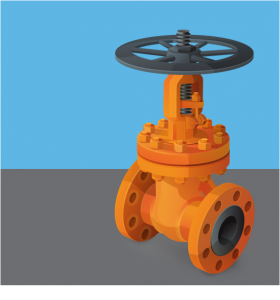Improving safety, efficiency and extending the service life of valves
Valves are critical to the safe and efficient operation of plants worldwide but corrosion, erosion and valve seizure are an ongoing challenge.
In this blog article we look at the challenges faced by valve components and the role that surface engineering services have to play in ensuring safe, efficient and long term operating valves.

The Challenges
Valve Corrosion
A large number of process chemicals (acids and alkalis) will attach to the discs and seatings of valves, as will salt water when taken up in large quantities for cooling – such is the case with electricity generating stations.
Protection for valve body, disc, and seating is integral to maximise the operating life of valves. At the same time many projects cannot support the high cost of valves with specially machined parts of non-corrosive, high-performance metals.
Valve Erosion
To remain cost-effective many plants must now operate 24 hours with continuous processes. This means valve interiors can be subjected to the scouring action of a continuous high-velocity flow of fluid.
With some fluids the abrasive action may be minimal but with others, say cooling water with a suspension of silt, the scouring action can be considerable – particularly when the valve is partly throttled.
Valve Seizure
Fluids containing solids often give rise to valve malfunctions by sticking – particularly where the solids may be gummy as in some food processing applications and where the valve is maintained in the open or shut position for long periods. Build-up takes place and solidifies around the disc or guideways so increasing the break-out torque and preventing the valve from being opened or shut.
The Solution
The Armourcote series of resin-bonded PTFE coatings, developed by our own technical team at Surface Technology, is a reinforced coating locked into a specially applied matrix of stainless steel with low-friction, easy-release characteristics which protect against corrosion and erosion.
Stainless steel is sprayed onto suitably prepared valve parts to produce a hard surface matrix into which the resin bonded PTFE is impregnated.
The resultant surface consists of minute stainless steel peaks with non-pourous chemically resistant resin bonded PTFE filling the valleys between the peaks.
Fine particles of PTFE suspended within the resin structure of the coating give the excellent lubrication properties of fluorocarbon; the resin base gives a tough, wear resistant and corrosion resistant coating while the stainless steel matrix provides a hard-supporting structure to mechanically bond the resin to the valve surface and give additional protection against wear.
The Result
Valve Corrosion Resistance
The fluoropolymer used in Armourcote is less microporous than PTFE alone, providing enhanced chemical and corrosion resistance.
When tested, coated samples immersed in a 30% concentration of salt water at room temperature was unaffected when inspected after 4,000 hours. Samples sprayed with a 5% salt water concentration for 1,000 hours were similarly unaffected. A series of tests have shown no noticeable corrosion takes place for Armourcote coated material at conditions equivalent to several years’ operation in a marine environment.
Using Armourcote enables a valve for use with corrosive fluids to be made from cast iron instead of stainless steel or other costly materials. The cost savings can be significant, yet they are made without sacrificing performance or reliability.
In fact, there are additional benefits to using Armourcote instead of exotic metals, particularly where the fluid may be tacky and the release properties of the coating are utilised.
Erosion Resistance
Two factors make valve surfaces coated with Amrourcote particularly resistant to erosion and surface wear:
- The inherent toughness of the resin structure in the fluoropolymer coating.
- The hardness and integrity of the sprayed stainless steel matrix.
Through the Armourcote process the resin coating, stainless steel matrix and valve surface are unified into an effective barrier against erosion. The contours of the stainless steel matrix act as a key for the coating and also provide minute plateaux of tough stainless steel. The surface is impervious to erosion from fluid flow – even when abrasive particles are in suspension in the fluid.
Seizure Prevention
In addition to its low coefficient of friction, the fluoropolymer coating of Armourcote has good release properties. This gives added protection to valves that might be left for long periods in one position and in which there is a likelihood of build-up in guides or around the disc. With some fluids, such as sugary foodstuffs, some build-up might still occur but this will immediately be released from the surfaces and flow away at the first movement of the valve mechanism.
Prevention of external valve corrosion in hostile environments
The external surfaces of valves operating in corrosive environments often require protection against chemical or environmental attack. Many different types of coating are available to give this protection to meet multiple specifications.
The type of coating recommended will be that best suited to the particular requirements of a specific application and may employ shot blast preparation and the application of primers, epoxies, bitumastics and alkyds metal spray. Application of the coating may be by normal paint spray systems or by electrostatic powder spray techniques.
To discover more about the valve coating services we provide and to discuss your requirements further, contact us now.
Register below for our monthly email and stay up-to-date with the latest surface engineering white papers, case studies and innovation news.

